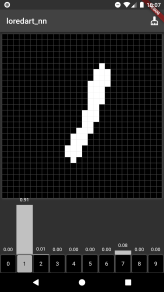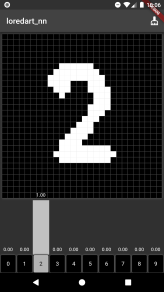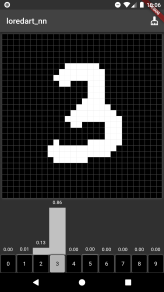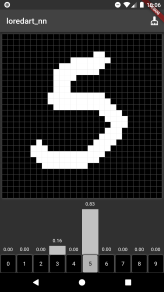LoreDart NN
Simple library for creating and training Deep Neural Networks, written in pure Dart.
Conceptually, the library has educational and entertainment purposes. Hope you will find it fun to use DNN with loredart_nn.
Getting started
Just import library into the project.
import 'package:loredart_nn/loredart_nn.dart';
NeuralNetwork usage
Here is a small example of creating MNIST classification Deep Neural Network:
Load the data
// List of 784 pixels for each digit
List<List<double>> xTrain = data[0].sublist(0,30000);
// One-Hot encoded digits' label
List<List<double>> yTrain = data[1].sublist(0,30000);
List<List<double>> xTest = data[0].sublist(30000);
List<List<double>> yTest = data[1].sublist(30000);I used the 'flatten' version of MNIST, where the digit's image flattened into the row of 784 pixels.
Define the model
var model = NeuralNetwork(
784, // input len = 784 pixels
[
Dense(64, activation: Activation.softplus()), //fully connected layer
Normalization(), // min-max normalization of the data
Dense(10, activation: Activation.softmax()) // output layers with softmax
],
loss: Loss.crossEntropy(), // cross entropt for One-Hot encoded target values
optimizer: SGD(learningRate: 0.01, momentum: 0.9), // optionally customize SGD optimizer with momentum > 0
useAccuracyMetric: true // for classification task you can use 'accuracy' metric
);Train the model
model.fit(xTrain, yTrain, epochs: 1, verbose: true);With verbose == true, you will see how the model is updating after each step, and summary information for each epoch, like that:
epoch 1/1 |100.00%| -> mean secs per train step: 0.00347s, mean loss [cross_entropy]: 0.332344, accuracy: 90.12%
For now, batch size of training is 1, which means that model will calculate gradients for each row of data and update weights and biases of trainable layers after each training step.
Test the model
history = model.evaluate(xTest, yTest, verbose: true)
print(history); // Output is a Map: {'mean cross_entropy': 0.237818, 'accuracy': 0.927833} Again, with verbose == true, you will see a little bit more information:
evaluating 12000/12000 |100.00%| -> mean secs per test step: 0.00025s, mean loss [cross_entropy]: 0.237819, accuracy: 92.78%
Use the model
Prediction is performed for many data rows at once, and output is a List of predictions for each input.
// data is some List of inputs
final prediction = model.predict(data); // model.predict returns prediction for each row in data
print(prediction[0].flattenList());
// prints something like [0.00, 0.00, 0.00, 0.99, 0.00, 0.00, 0.00, 0.00, 0.00, 0.00]The output of the single prediction is the
Matrixinstance
To extract values from Matrix you can use Matrix().matrix getter or Matrix().flattenList() method. Additionally you can read docs from Matrix class.
Save and load weights of model
You can save weights and biases of trainable (aka Dense) layers into some directory.
// save parameters into the `mnist_classifier/model_weights.bin` file
model.saveWeights('mnist_classifier')
saveWeightsmethod saves only weights and biases of Dense layers
Then you can load weights and biases into the model, but be sure you use appropriate architecture, or the results of the loaded model won't meet expectations.
model.loadWeights('mnist_classifier')If you want to load weights from Flutter assets, use the loadWeightsFromBytes method.
var model = NeuralNetwork(...)
rootBundle.load('assets/model/model_weights.bin').then((value) {
model.loadWeightsFromBytes(value.buffer);
});Flutter example with NeuralNetwork model
Simple example of using MNIST classifier within Flutter app.
Working Flutter project can be found under the example folder.
Additional information
Supported layers:
Dense- a regular fully connected layer with weights, biases and activation function.Normalization- the data normalization layer; supports two normalizations:min-maxandz-score.Input- a special layer that is generated by the NeuralNetwork.
Supported activations:
Activation.sigmoid()- Sigmoid activation functionActivation.swish()- Swish activation functionActivation.softplus()- Softplus activation functionActivation.softmax()- Softmax activation functionActivation.relu()- ReLU activation functionActivation.leakyReLU()- Leaky ReLU activation functionActivation.elu()- ELU activation function
Supported losses:
Loss.mae()- Mean Absolute Error lossLoss.mse()- Mean Square Error lossLoss.crossEntropy()- Cross Entropy lossLoss.sparseCrossEntropy()- Sparse Cross Entropy loss
Supported optimizers:
For now, loredart_nn has only one optimizer:
SGD with momentum.



